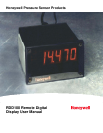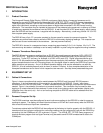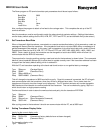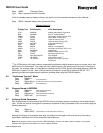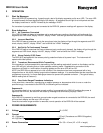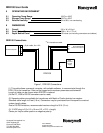
RDD100 User Guide
www.honeywell.com 3
1 INTRODUCTION
1.1 Product Overview
The Honeywell Remote Digital Display, RDD100, produces a digital display of measured pressures and is
designed for use with RS-232 versions of Honeywell HPA, HPB, PPT, PPTE, and PPTR pressure transducers.
The 6-digit display features 0.56 inch-tall LED characters that are readable in bright sunlight. The RDD100 is a
digital-input instrument, accepting a continuous stream of digital data transmitted in RS-232 format from the
transducer. The transducer may be installed at the source of the pressure being measured; a cable up to 50 feet
in length may separate the transducer from the RDD100. A wall-mounted AC-to-DC power supply, which powers
both the RDD100 and the transducer, is supplied with the display. Alternatively, a user may provide 12V ± 3V DC
from a system power supply.
The RDD100 has a 9-pin “D” connector mounted on the rear panel to connect to a personal computer. The
computer can perform data collection while the RDD100 is continuously displaying readings. The computer can
also be used to send commands to the transducer (two-way communications).
The RDD100 is housed in a compact enclosure, measuring approximately 3.8 x 2 x 4.4 inches, W x H x D. The
instrument may be used on a tabletop or can be easily installed in a panel using the supplied mounting hardware.
1.2 Pressure Transducer Description
The RDD100 receives pressure readings from an RS-232, Honeywell pressure transducer (HPA, HPB, PPT,
PPTE and PPTR). Accuracy of the displayed pressure reading is determined solely by the accuracy of the
transducer. Typical PPT accuracy, for example, is ±0.05% of full scale (FS). Digital output resolutions up to
0.0011% FS are possible but are dependent upon the pressure display units selected. Although many of the
support transducers also have a 0-5V analog output, only the digital output is used by the RDD100 as it provides
better resolution and accuracy. Any of 16 different pressure display units may be selected for use with the
RDD100. A list of available pressure units is shown in section 2.4 below. A more complete description of the
Honeywell transducers can be found in their respective user manuals. See http://www.pressuresensing.com.
2 EQUIPMENT SET UP
2.1 Cables & Connections
Figure 1 shows connections that must be made between the RDD100 and Honeywell RS-232 pressure
transducer. A six foot long cable for this connection is supplied with the RDD100. Figure 1 also shows
connections to the 12V DC input power. To obtain transducer pressure readings, only these two connections are
needed. Figure 1 also shows a connection to a personal computer. This connection may be used for data
logging or to communicate with the transducer in order to set up and change various parameters (display units,
integration time, idle count, etc). A six or ten foot long computer-to-RDD100 cable can be selected when the
RDD100 is ordered.
2.2 Personal Computer Set Up
The RS-232 transducer must be configured to send continuous readings to the RDD100 in order for pressure
readings to appear. The display will remain blank and the error LED will be lit continuously when the RDD100
fails to receive continuous input from a transducer.
Transducers ordered with the RDD100 will be configured at the factory to function properly with the RDD100. A
transducer that has not been configured for continuous readings can be configured for use with the RDD100 by
connecting it to the COMM port of a PC as shown in Figure 1. The HPA/B, PPT, PPTR/E Demo program or a
terminal emulator program such as HyperTerminal, may be used to send RS-232 formatted serial data to the
COMM port.



